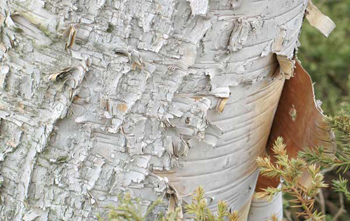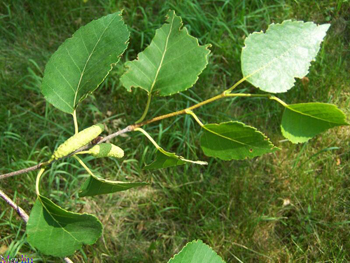Contents:
Common Names | Parts Usually Used | Plant(s) & Culture | Where Found | Medicinal Properties | Biochemical Information
Legends, Myths and Stories | Uses | Formulas or Dosages | Bibliography
Scientific Names

- Betula alba L.
- Betulaceae
- Birch family
Common Names
- Canoe birch
- Cherry birch
- Hua-mu
- Mountain mahogany
- Paper birch
- Spice birch
- Sweet birch
- White birch
Parts Usually Used
Young leaves, inner bark, leaf buds
Back to Top

Description of Plant(s) and Culture
White birch is a tree grows to a height of 65 feet; it has chalky white bark which can be peeled off in horizontal strips. Its leaves are cordate, bright green above and lighter beneath, serrate, and glabrous or minutely hairy. The flowers are borne in yellowish male and gray-green female catkins. When the male catkins turn yellow with pollen, the green female catkins enlarge to produce numerous two-winged seeds, developing into seed cones. Flowers seen in April-May.
Back to Top
Where Found
Found growing in the northern United States, Canada, and the northern part of Europe. Upland woods, often in pure stands, from Labrador to Alaska, near the northern limit for trees, south to North Carolina and Colorado, in mountains in the south of its range.
Back to Top
Medicinal Properties
Astringent, diuretic, diaphoretic
Back to Top
Biochemical Information
Saponins, traces of essential oil, tannin, bitter principle, glycosides
Back to Top
Legends, Myths and Stories
The inner bark contains an oil which is identical in flavor with that of the wintergreen plant (Gaultheria procumbens). A wholesome wintergreen-flavored tea may be made by pouring boiling water or boiling birch sap over diced pieces of the inner birch bark or birch twigs and letting it steep for a few minutes.
According to legend, Christ was beaten with birch rods. The fasces, a bound bundle of birch sticks enclosing an axe with the blade projecting, were carried by Roman soldiers in advance of emperors or important officials. These fasces symbolized the state’s power to punish by flogging (the birch sticks) or by putting to death (the axe).
Birch wood has been used for furniture, wooden spoons, tool handles, and broomsticks. Witches on Walpurgis Night were said to have ridden on broomsticks made of birch. Native Americans used the water-resistant birch bark for their canoes and wigwams.
To the people of northern Europe, the birch was a sacred tree. In the Kalevala, a Finnish epic, the birch is designated as a holy tree of great use to mankind. The Germanic peoples dedicated it to their god of thunder, Thor.
Back to Top
Uses
The Paper Birch leaf tea is reported to eliminate gravel and dissolve kidney stones when taken daily for a time, 1 to 1 1/2 cups a day. A decoction of the leaves is sometimes recommended for baldness; or try the fresh expressed juice. Mild sedative. Use a wash or bath additive for chronic or severe skin problems. The inner bark contains an oil which is sometimes substituted for wintergreen in liniment. Relieves headaches, menstrual cramps, abdominal cramps, gout, dropsy, acne, eczema, pruritis, rheumatism pains, diarrhea, colic, colitis, and dysentery. The liquid from boiling bark can be used to wash sores and wounds, boils, expels worms. Sap can be taken as a spring tonic or used as a hair tonic.
Beer is often made from the sap of sweet birch. A type of oil of wintergreen is distilled from the inner bark and twigs.
Back to Top
Formulas or Dosages
The leaves must be used fresh.
Infusion: use 1 tbsp. leaves with 1/2 cup water.
Decoction: use 1 tbsp. leaves with 1/2 cup water. Boil briefly, let stand for 2 hours, then add 1/2 tsp. bicarbonate of soda. Take up to 1 cup a day.
Expressed juice: take 1 tsp. at a time, as required.
Back to Top
Bibliography
![]() The Herb Book
The Herb Book, by John Lust, Bantam Books, 666 Fifth Avenue, New York, NY. copyright 1974.
![]() Eastern/Central Medicinal Plants
Eastern/Central Medicinal Plants, by Steven Foster and James A. Duke., Houghton Mifflin Company, 215 Park Avenue South, New York, NY 10000
![]() The Nature Doctor: A Manual of Traditional and Complementary Medicine
The Nature Doctor: A Manual of Traditional and Complementary Medicine, by Dr. H.C.A. Vogel; Keats Publishing, Inc., 27 Pine Street (Box 876) New Canaan, CT. 06840-0876. Copyright Verlag A. Vogel, Teufen (AR) Switzerland 1952, 1991
![]() Chinese Medicinal Herbs
Chinese Medicinal Herbs, compiled by Shih-Chen Li, Georgetown Press, San Francisco, California, 1973.
Herbal Gardening, compiled by The Robison York State Herb Garden, Cornell Plantations, Matthaei Botanical Gardens of the University of Michigan, University of California Botanical Garden, Berkeley., Pantheon Books, Knopf Publishing Group, New York, 1994, first edition
 The Magic of Herbs
The Magic of Herbs, by David Conway, published by Jonathan Cape, Thirty Bedford Square, London, England. (Out of print)
![]() Planetary Herbology
Planetary Herbology, by Michael Tierra, C.A., N.D., O.M.D., Lotus Press, PO Box 325, Twin Lakes. WI 53181., Copyright 1988, published 1992
![]() The Complete Medicinal Herbal
The Complete Medicinal Herbal, by Penelope Ody, Dorling Kindersley, Inc, 232 Madison Avenue, New York, NY 10016, First American Edition, copyright 1993
![]() Indian Herbalogy of North America
Indian Herbalogy of North America, by Alma R. Hutchens, Shambala Publications, Inc., Horticultural Hall, 300 Massachusetts Avenue, Boston, Massachusetts 02115, 1973
![]() American Folk Medicine
American Folk Medicine, by Clarence Meyer, Meyerbooks, publisher, PO Box 427, Glenwood, Illinois 60425, 1973
![]() Webster’s New World Dictionary
Webster’s New World Dictionary, Third College Edition, Victoria Neufeldt, Editor in Chief, New World Dictionaries: A Division of Simon & Schuster, Inc., 15 Columbus Circle, New York, NY 10023
 How Indians Use Wild Plants for Food, Medicine & Crafts
How Indians Use Wild Plants for Food, Medicine & Crafts, by Frances Densmore, Dover Publications, Inc., 180 Varick Street, New York, NY 10014, first printed by the United States Government Printing Office, Washington, in 1928, this Dover edition 1974
 An Instant Guide to Medicinal Plants
An Instant Guide to Medicinal Plants, by Pamela Forey and Ruth Lindsay, Crescent Books (January 27, 1992).
 The Rodale Herb Book: How to Use, Grow, and Buy Nature’s Miracle Plants (An Organic gardening and farming book)
The Rodale Herb Book: How to Use, Grow, and Buy Nature’s Miracle Plants (An Organic gardening and farming book), edited by William H. Hylton, Rodale Press, Inc. Emmaus, PA, 18049., 1974
 The Healing Plants
The Healing Plants, by Mannfried Pahlow, Barron’s Educational Series, Inc. 250 Wireless Blvd., Hauppauge, NY 11788, 1992
